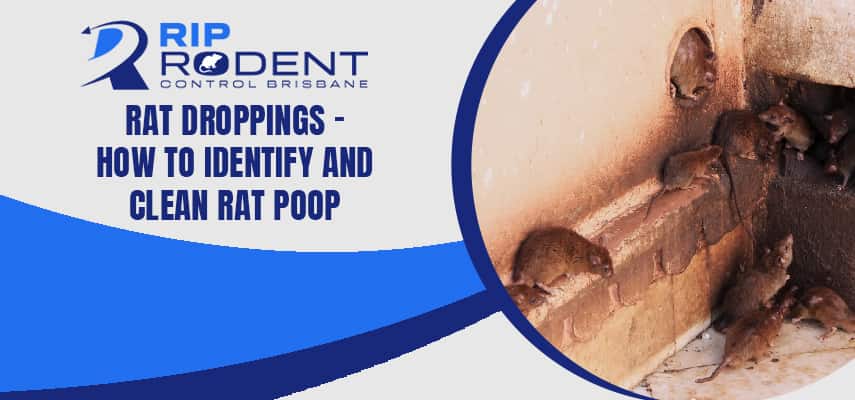Rat Droppings – How To Identify And Clean Rat Poop
Rat droppings are a common sight in homes and businesses, especially in areas where rats have found their way inside. However, it’s not just the sight of rat poop that’s a problem, but also the potential health risks that come with it. Rat droppings can carry dangerous diseases such as Hantavirus, Salmonella, and Leptospirosis. In this blog, we’ll discuss how to identify rat poop and how to clean it up safely.

Identifying Rat Droppings
Rat droppings can be identified by their shape, size, and colour. They are typically elongated, spindle-shaped, and have pointed ends. They are usually about 1/2 inch to 3/4 inch long and about 1/4 inch in diameter. Rat droppings are usually dark in colour, ranging from black to dark brown. They may also have a glossy surface, which is a result of the oil and grease in their diet. Rat droppings are also distinctive because of their ridges and pointed ends. They can be found in various places, including attics, basements, and kitchen cabinets. It is important to handle rat droppings with caution as they can contain harmful bacteria and diseases. It is recommended to wear gloves and a mask when cleaning up rat droppings and to disinfect the area thoroughly.
Cleaning Up Rat Droppings
Cleaning up rat droppings is an important task that should be approached with caution due to the potential health hazards associated with the droppings. Below are the steps to follow for proper and safe cleaning of rat droppings:
Preparation: Before starting the cleaning process, it is important to protect yourself by wearing gloves, a mask, and protective eyewear. This will prevent the transmission of bacteria and diseases that may be present in the droppings.
Removing Droppings: Start by removing as many droppings as possible using a paper towel or disposable cloth. Avoid using a vacuum cleaner or broom to sweep the droppings as this will cause the droppings to become airborne, increasing the risk of exposure to harmful bacteria and diseases.
Disinfecting: After removing the droppings, the area should be thoroughly disinfected. Use a solution of equal parts water and white vinegar or a disinfectant cleaner recommended for use on hard surfaces. Apply the solution to the area, making sure to cover all the droppings and surrounding surfaces. Allow the solution to sit for 10-15 minutes to allow for proper disinfecting.
Cleaning: After the disinfectant solution has sat for the recommended time, clean the area with a damp cloth to remove any residue. Avoid using too much water, as this could cause the droppings to become airborne.
Drying: After cleaning the area, it is important to allow it to air dry completely. This will ensure that all the moisture from the cleaning process has been removed, reducing the risk of mould growth.
Final Cleaning: Finally, it is recommended to vacuum the area to remove any remaining debris and droppings. Dispose of the vacuum bag or empty the canister outside to prevent contamination of your living space.
It is important to clean up rat droppings promptly and properly to avoid potential health hazards and maintain a clean and safe living environment.
How Can Professionals Identify The Rat Droppings And Get Rid Of Them?
Professional pest control companies are equipped with the tools, techniques, and expertise to identify and get rid of rat droppings. Here’s a detailed explanation of how professionals can identify and eliminate rat droppings:
Step 1: Inspection
The first step in identifying and getting rid of rat droppings is conducting a thorough inspection of the premises. This includes searching for signs of rat activity, such as gnaw marks, droppings, and urine stains. Professionals also look for entry points where rats may have entered the building and any potential food sources that may be attracting them.
Step 2: Identification of Rat Droppings
Once the inspection is complete, professionals can identify rat droppings by their distinctive shape and size. Rat droppings are approximately 1/2 inch long and 1/4 inch in diameter, and have a dark color. They are also oval-shaped and have ridges and pointed ends.
Step 3: Cleaning
After identifying the rat droppings, the next step is cleaning up the droppings and sanitizing the area. Professional pest control companies follow strict protocols and use personal protective equipment, such as gloves and masks, to avoid exposure to dangerous pathogens that may be present in the droppings. They use disinfectants and cleaning solutions to clean up the droppings and sanitize the affected area.
Step 4: Elimination of Food Sources
In addition to cleaning up the droppings, professionals also focus on eliminating food sources that may be attracting rats to the premises. This includes securing garbage cans and removing any piles of debris that may be providing a food source for rats.
Step 5: Rodent Proofing
Once the droppings have been cleaned up and food sources have been eliminated, professionals focus on rodent-proofing the premises. This involves sealing all entry points, such as cracks and holes, to prevent rats from entering the building again. Professionals use materials that are durable and long-lasting to ensure that the rat-proofing measures are effective.
Step 6: Monitoring
After the rat-proofing measures have been implemented, professionals monitor the premises to ensure that rats are not present. They also check for any new droppings or signs of rat activity and take appropriate measures if necessary.
Hire Professionals- If you live in Brisbane, the best option for you is to go with hiring the professionals at Rip Rodent Control Brisbane They have an experience of more than 10 years. They help in getting rid of rats and also all other pests as well at affordable prices. To hire them, you can give them a call on 07 3186 8640.
Published on: February 7, 2023
Last updated on: February 10, 2023
